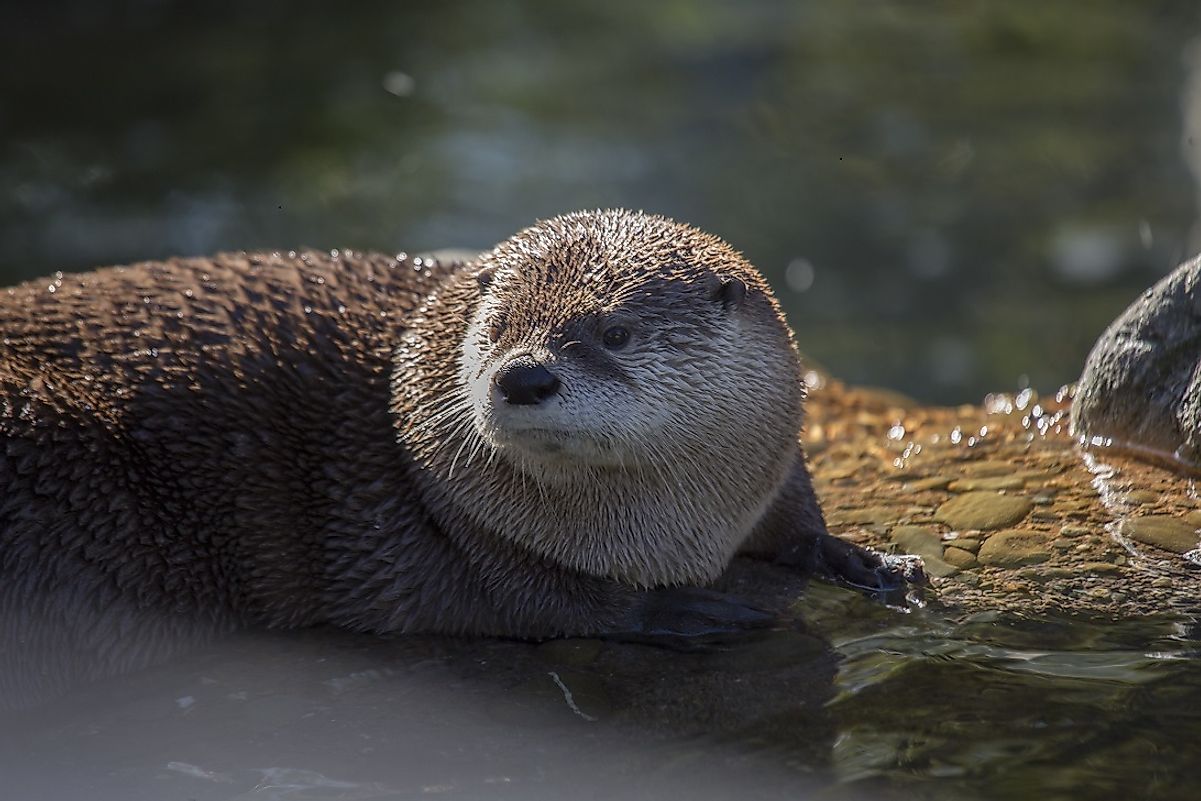River Otter Facts: Animals of North America

5. Physical Description
North American River Otters are large compared to most other semi-aquatic mammals, and adults can be as long as 5 feet and weigh more than 30 pounds. Their thick fur is both water-repellent and an effective insulator against temperature extremes. Otters are slender, streamlined, and flexible, which serves them well for a life in underground tunnels, and waters often congested with floating debris and aquatic plants. Most are dark brown in color, with lighter patches on their throats and chests. In contrast to their very short legs in relation to their body sizes, otters’ tails are usually around a third of their entire body lengths. Otters belong to the Mustelidae family of carnivores, which includes wolverines, minks, ferrets, badgers, and weasels. Almost all North American River otters live in wetlands close to bodies of water. Like coyotes, otters often were depicted as “trickster” characters in Native American folktales and mythology. Their scientific name, Lontra Canadensis, means “Canadian Otter”.
4. Diet
While otters prefer to dine on slow-moving fish (which are easier to catch), they will also eat game fish, crustaceans and mollusks, aquatic reptiles, amphibians, birds, insects, and smaller semi-aquatic mammals as availability dictates. Otters usually hide and launch surprise, lunging attacks on their prey. They may eat smaller kills in the water, but bring larger ones to shore.
3. Habitat and Range
North American River otters may be commonly found throughout much of sub-Arctic Canada, Alaska, and, within the contiguous United States, in the Pacific Northwest and along the Atlantic Coast and Gulf of Mexico. While North American River otters are rather high up on the food chain, they do in fact have several natural predators. In water, especially along the Gulf Coast, crocodilian reptiles are real threats. Terrestrial predators of otters include black bears and a variety of Feline and Canine species, domesticated and feral alike. Despite receiving a conservation status of “least concern”, across much of its natural range the North American River Otter is becoming an increasingly rare sight to see. After centuries of exploitation of otters for their commercially lucrative coats, human activities continue to threaten them, though today many of these threats are indirect, and the fur trapping industry has been altered in the wake of commercial fur farms, consumer preferences, environmental lobbying, and governmental regulations.
As a predator well up in the wetland food chain, North American River Otters are especially susceptible to environmental toxins, such as agricultural pesticides and motor vehicle exhaust and oil run-off. Though these may trickle into the small animals and fish that otters eat in small quantities, they can become concentrated within the otters themselves. As otters consume large numbers of other animals with low levels of toxins, these accumulate in higher concentration in the otters as many of them are slow to be removed from the body via excrement and urine. Like all wetland animals, otters are facing increasing danger from habitat depletion and fragmentation due to human development, such as road construction, housing subdivisions, and unsustainable agricultural and forestry practices. Climate change also plays a role, as some wetlands are becoming increasingly dry, others actually receiving too much rain, and rising temperatures are changing the flora and fauna demographics within all.
2. Behavior
North American River otters make their homes in underground burrows near waters’ edges. Though habitat loss and food availability may force otters to migrate elsewhere, they will usually stay put in the same areas from year to year. Employing a variety of two-limb, four-limb, and tail-propelled paddling strokes, otters are proficient swimmers. Active burrowers and hunters year-round, otters are more active at night during warmer months, and more at night during the winter season. Constantly on the move, river otters may cover as much as 26 miles (a Marathon!) in a single day over land and water, especially during the summer. Otters are more social than their wolverine, badger, and weasel cousins. While females often live with their young, groups of males often congregate with one another.
1. Reproduction
River otters prefer to mate over winter or in early spring, and reach sexual maturity at around two years of age. Copulation may last longer than an hour, and may occur in water or on land. North American River otters typically do not have life partners, and may mate with several partners in a season. Although pregnancies only last around 2 months, female otters often practice “Embryonic diapause”, wherein they delay sperm implantation for 8-10 months. Due to this delay, a year may pass between breeding and birth. Litter sizes range between 1 and 5 otter “pups”, and they are typically weaned after 12 weeks from birth.







